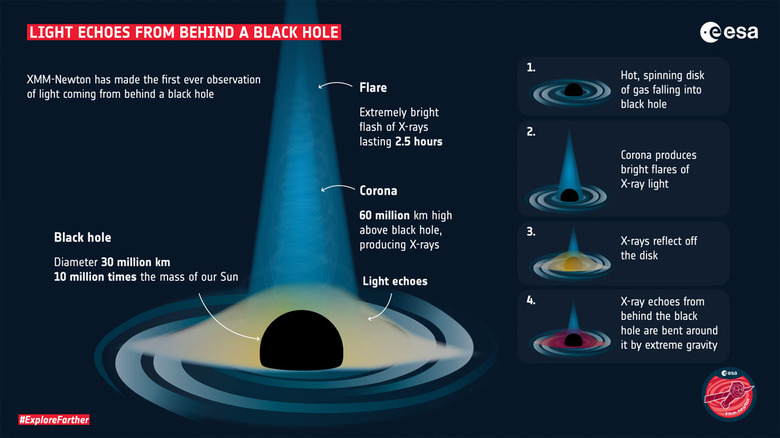Astrophysicists Detect Light Coming From Behind A Black Hole
Astrophysicists from Stanford have reported the first detection of light coming from behind a black hole. The detection of light fulfills a prediction made by Einstein's theory of general relativity. Researchers observed a series of bright flares of x-rays, which weren't unexpected. What was unexpected was that the telescopes recorded additional flashes of x-rays that were smaller, later, and of different "colors" than the bright flares initially observed.The researchers theorize that these luminous echoes are consistent with x-rays reflected from behind the black hole. Stanford University astrophysicist Dan Wilkins says light that goes into a black hole doesn't come out, so we shouldn't see anything that's behind it. Walkins says the reason we're able to see the x-rays from behind is because the black hole is warping space, bending light, and twisting magnetic fields around itself.
This is the first direct observation of light from behind a black hole, a scenario predicted by the theory of general relativity but never confirmed until now. The observation of light from behind the black hole wasn't the goal of the research. The original motivation of the researchers was to learn more about a mysterious feature of some black holes called a Corona.
As material falls into a supermassive black hole, it creates some of the brightest continuous sources of light in the universe. As the light is created, it forms a corona around the black hole. Researchers note that the light is x-ray light and can be analyzed to map and characterize a black hole. The leading theory for what a corona is has to do with gas sliding into the black hole where it superheats to millions of degrees.

At such a high temperature, electrons separate from their atoms, creating magnetized plasma. Due to such high gravity around the black hole, the magnetic field arcs so high above the black hole and twirls around itself so much that it eventually breaks. The magnetic field gets tied up and then snaps close to the black hole and heats everything around it, producing high-energy electrons that produce x-rays. Observations of the black hole are ongoing and will leverage the ESA x-ray observatory called Athena in the future
